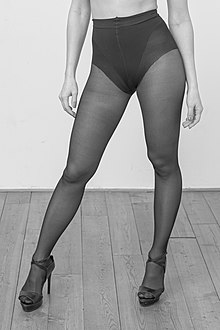Pantyhose
Pantyhose, sometimes also called sheer tights, are close-fitting legwear covering the wearer's body from the waist to the toes.
In American English, the term "tights" typically refers to pantyhose-like garments made from thicker material, which are generally opaque or slightly translucent.
[7] In cases of high-cut legs or fabrics that would produce a visible panty line, it was a practical necessity to wear them as the only lower undergarment.
During the 1940s and 1950s, stage and film producers would sew stockings to the briefs of their actresses and dancers, as testified to by singer-actress-dancer Ann Miller.
In 1953, Allen Gant Sr. of Glen Raven Knitting Mills developed a commercial equivalent to these hose that he named "Panti-Legs", but these were not brought to the open market until about 1959.
[10] During this time, Ernest G. Rice invented his own design for pantyhose similar to those worn today, and in 1956 he submitted a patent titled "Combination Stockings and Panty".
[11] This design was adopted by other makers, and this caused disputes in U.S. courts for many years before the patent was upheld some time after Rice's own death.
[12] Meanwhile, the yarn manufacturer Chemstrand already presented a product with an opaque panty part and gusset called leotard-stockings in November 1958.
[13] In 1974, actress Julie Newmar successfully filed a patent for "Pantyhose with shaping band for cheeky derriere relief", a garment innovation made famous through the costume she designed in the 1960s for her role as Catwoman in the TV show Batman.
Up until this time, there was little reason for women outside show business to wear "panty hose", as the longer hemlines allowed for the use of over-the-knee stockings secured with a garter belt.
[16][17] Pantyhose generally have a standard construction: the top of the waist is a strong elastic; the part covering the hips and the buttocks (the panty area) is composed of a thicker material than for the legs.
The disadvantages of pantyhose includes: In the UK, local authorities accept clean, dry textiles along with other recyclables.
Textiles (including tights, pantyhose and stockings) which cannot be re-worn are recycled and turned into things like roofing felt.
[23] Some fishermen who surf fish from tropical beaches may wear pantyhose for protection from jellyfish whose stingers are triggered by contact with a chemical on bare skin.





